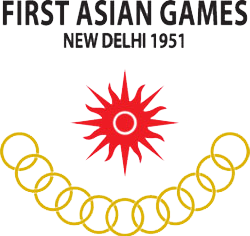1951 Asian Games medal table

Logo of the 1951 Asian Games
|
|||
| Host city | New Delhi, India | ||
|---|---|---|---|
| Motto | Play the game, in the spirit of the game | ||
| Nations participating | 11 | ||
| Athletes participating | 491 | ||
| Events | 57 | ||
| Opening ceremony | 4 March | ||
| Closing ceremony | 11 March | ||
| Officially opened by |
Rajendra Prasad President of India |
||
| Athlete's Oath | Baldev Singh | ||
| Torch lighter | Dalip Singh | ||
| Main venue | National Stadium | ||
|
|||
The 1951 Asian Games, officially known as the First Asian Games, was a multi-sport event celebrated in Delhi, India from 4 to 11 March 1951. The Games received names like First Asiad and 1951 Asiad. A total of 489 athletes representing 11 Asian National Olympic Committees (NOCs) participated in 57 events from eight sports and discipline. The Games was the successor of the Far Eastern Games and the revival of the Western Asiatic Games. The 1951 Asiad were originally scheduled to be held in 1950, but postponed until 1951 due to delays in preparations. On 13 February 1949, the Asian Games Federation was formally established in Delhi, with Delhi unanimously announced as the first host city of the Asian Games.
The games were managed by a strong Organising Committee (see Organisation below).
Countries invited included almost all the independent Asian countries of the time except Soviet Union and Vietnam, due to the political structure of those nations.
National Stadium was the venue for all events. The official logo of the First Asiad depicted a bright sun in red with 16 rays and a white circle in the middle of the disc of the sun and eleven rings, representing each participating nation, on a white background, symbolising peace.
Japanese athletes won the most golds and overall medals, with 24 and 60 respectively; while the host nation India had the 15 golds and 51 overall medals with most bronzes (20) and finished at second spot in a medal table. The next Asian Games organised by India were the 1982 Asian Games, some 31 years later.
1951 Asian Games, thus Asian Games are considered to be a successor of a small-scale multi-sport event known as the Far Eastern Games, held in between a period of 1913 to 1938 in the different cities of Japan, Philippines, and mainland China. The First Far Eastern Games took place in Manila, Philippines in 1913, after the efforts made by the Philippine Amateur Athletic Federation (PAAF). The Games were successfully organised for the next nine terms, but in September 1937, Japan invaded China after the Marco Polo Bridge Incident and started the Second Sino-Japanese War (which later became part of the World War II), thus the originally planned Games of 1938 in Osaka was cancelled and the Far Eastern Games were discontinued thereafter.
...
Wikipedia
